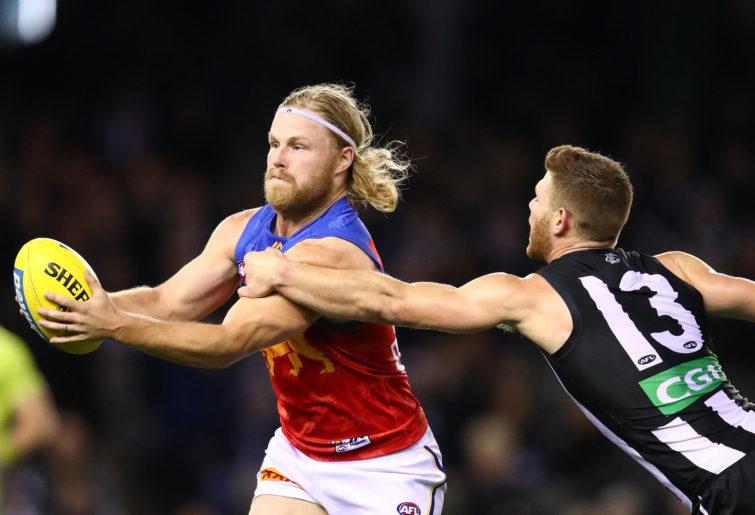It’s taken some time but the Brisbane Lions have finally entered their premiership window.
For Lions fans, the last three seasons have been somewhat bittersweet.
The sudden rise to becoming a regular top-four finisher was swift, yet welcomed. The fact that it has resulted in one win and five losses in three finals series leaves a little bit of a sour taste in the mouth of all stakeholders.
It isn’t a big statement to even tip the Lions for the flag – many people in the AFL community are of the belief that there are only three contenders, and Brisbane is well and truly one of them.
After the third successive ‘failed’ finals series though, the end of 2021 saw a number of key media personalities questioning whether Brisbane had enough to progress to the upper echelon.
Realistically, though, 2022 is the season the Lions have officially become a contender.
2019 was the second-placed finished very few saw coming after five consecutive bottom-four finishes, although the competitiveness of the team in 2018 was indicative of a team heading in the right direction. The shock of Brisbane’s rise caught every club off guard.
This is maybe where it gets a little sticky, as the 2020 second-placed finish was more of a mirage than a genuinely strong result.
The Lions started off that season horribly against the Hawks before COVID struck and the entire competition was predominately moved to Queensland.
Seven of Brisbane’s 15 wins came by 20 points or under and they were able to play all bar two games in their home state once the season recommenced, swinging the results heavily in their favour.
A slow start to 2021, again COVID-affected, probably restricted the heights in which the team could reach, but a few key injuries and a need to fill gaps on the fly seemingly took its toll as the season wore on.
Now, the Lions have a squad that has plenty of finals experience and knows what regular season success tastes like, which is only beneficial going forward.

(Photo by Chris Hyde/Getty Images)
The performance in Round 1 against the Power was a fantastic indicator of how well their unique game plan has developed to a point of being premiership-worthy.
A hard-fought game resulting in a come-from-behind win by 11 points was a perfect way to kick off the season. The Lions had six more scoring shots and expected scores indicate that the margin should’ve been greater, had Brisbane been more punishing in front of goal.
Brisbane’s brilliance is in their efficiency. This isn’t necessarily indicated in literal disposal efficiency, clanger counts or individual turnover numbers, but rather, every movement and possession has a purpose at the Lions.
The way in which Melbourne won the premiership and became a team that looks in the formative stages of a dynasty, was to create a team where there were 22 roles on the team and each player knew exactly what was required of them, becoming the most well-rounded team in the league without a passenger and having a fitness base that allowed them to run out games better than any other side.
Brisbane’s last three seasons may have resulted in just one finals win but they have also proven to be three separate seasons to tinker with a tactic that can become unbreakable.
Since moving up the ladder, the Lions have become the kings of kick-to-handball ratios, preferring to maximise the long-range kicking of its players to overwhelm the opposition.
The fact many night games in Queensland are played in dewy conditions reduces the need to necessarily be accurate and places greater emphasis on simply getting the ball forward.
Initially, it was all about outscoring the opposition and playing at a blistering pace. Lockdown spots in the defence were lacking in quality and the key personnel were still at a spot of development, while the likes of Lachie Neale, Stef Martin, Jarryd Lyons and Dayne Zorko were dominant forces through the middle at the peak of their powers.

(Photo by Chris Hyde/Getty Images)
They got 57 goals out of Charlie Cameron and had seven players finish with over 20 goals for the season, a remarkable result.
In 2020, they increased their kick-to-handball ratio to 1.85:1, from 1.76:1 previously, and were entirely manic with the ball use and transitional play – the Lions were ranked dead last in the competition for disposals, yet ranked third for inside 50s, metres gained and points scored.
That season, with shortened quarters, the Lions decided that ball retention was a better way to use the ball at pace, ranking third for marks, while we saw the introduction of “locking the ball in”. They ranked third for tackles inside 50, with the game length beneficial for the small forwards to attack the opposing defenders.
2021 felt like a big step in the right direction. The Lions were the league leaders in clearances, inside 50s and points scored, second for metres gained but based on how they’d gone previously, we saw definite changes to the style.
Having been ranked eighth and seventh the previous two seasons for tackles, they ended 2021 ranked fifth. Tackles inside 50 went up to second, just behind the Demons in full-length matches, and quite crucially, the Lions’ defence improved considerably, conceding the fifth-fewest points in the league.
This is despite the fact that Brisbane continued to concede more inside 50s than all bar one other finalist (GWS), highlighting just how good Harris Andrews and Brandon Starcevich were in their roles, with the rotation of Darcy Gardiner and Marcus Adams based on fitness.
Chris Fagan purposely dropped the importance of marks (dropped from third to eighth) in order to increase the appetite of the tackling – Daniel Rich was the league leader in metres gained averaging 630 per game and was joined by four other teammates with over 400 metres gained per game, sending the ball inside 50 the most of any team in the league.

(Photo by Scott Barbour/Getty Images)
The buy-in of the forwards to apply pressure inside 50 was superb, with nine players averaging at least a tackle inside 50 per game, including key forward Daniel McStay, who ranked second.
While the end of the 2021 season might’ve left Brisbane fans feeling heartbroken, it set the course for what is a genuine contender for a number of years to come.
Brisbane have solidified their defensive unit into what should be ranked in the top four this season, with Noah Answerth like a new recruit.
The midfield gains ascendancy in stoppage situations and all the players that rotate through there have increased their kicking numbers significantly to match the club’s ethos.
Even without Eric Hipwood, the offence is as dangerous aerially as it now is with its pressure, and only poor goalkicking tends to restrict the margin Brisbane ends up winning by.
Most importantly, the way each part of the ground works together, whether it be score launches out of defence, defensive running from the midfield or contested work in the air to win contests, the Lions work almost like an effortless production line with no clear weakness slowing it down.
Of course, this isn’t a team that will go undefeated, just as the Demons weren’t able to in 2021.
But if there’s one team that has a unique style with the buy-in of all 22 players and no passengers that can rival last year’s premiers, it’s Chris Fagan’s team that has now entered the upper echelon of the league.
The fact they ran over the top of the Power and were as dominant in the air as they were efficient in setting teammates up with skill and guile bodes well for the season ahead.
Make no mistake, the Brisbane Lions are finally here.
It’ll be up to 17 other clubs to figure out how to stop them.































































































